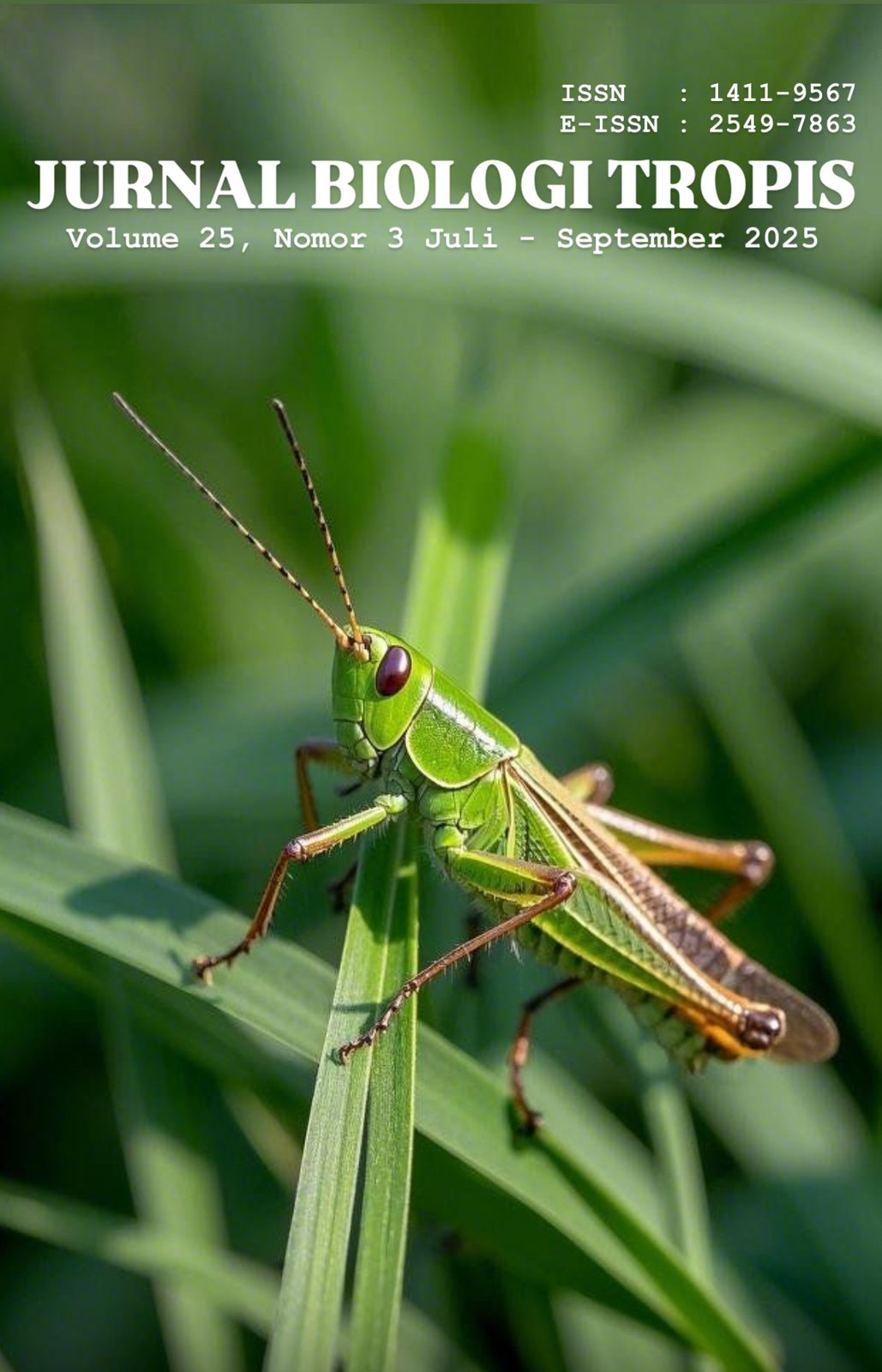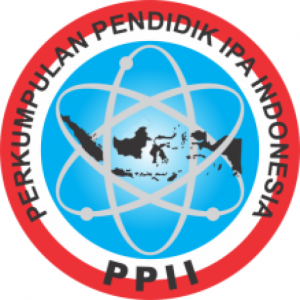Insect Species Composition in Local Durian Loji Plantation in Karawang, West Jawa
Authors
Hanifa Khansa Sabrina , Siti Latifatus Siriyah , Nurcahyo Widyo Daru SaputroDOI:
10.29303/jbt.v25i3.9193Published:
2025-07-09Issue:
Vol. 25 No. 3 (2025): Juli-SeptemberKeywords:
Agroecosystem, conservation, durian, insect diversity, Karawang.Articles
Downloads
How to Cite
Downloads
Metrics
Abstract
Durian (Durio zibethinus) belong to a popular fruits in Southeast Asia and is widely distributed across various regions, particularly in Indonesia. Karawang regency, as one of the part of west java province, is one of the producers of local durian, known as durian loji. Successful durian cultivation is influenced by various biotic factors, among which insect biodiversity plays a critical role in pollination, pest control, and nutrient cycling. However, comprehensive studies on insect diversity in durian agroecosystems, particularly in Karawang, remain scarce. This study aimed to explore the insect community structure within Loji durian plantations to provide baseline data on species composition and ecological roles. Field sampling was conducted using three methods: sweep nets for aerial insects, beating sheets for foliage-dwelling species, and pitfall traps for ground-active arthropods. A total of 29 insect morphospecies from 9 orders were identified, including Coleoptera, Hymenoptera, Diptera, Dermaptera, Orthoptera, Hemiptera, Odonata, Mantodea, and Lepidoptera. Our findings show that all morphospecies occupied various trophic levels, including herbivores, predators, and decomposers. These findings highlight the ecological significance of insects in maintaining durian plantation health and suggest the need for sustainable farming practices to conserve beneficial species while managing pests. Further research should investigate the seasonal variations and the impact of agricultural practices on insect community structure and diversity.
References
Alrazik, M. U., Jahidin, J., & Damhuri, D. (2017). Keanekaragaman Serangga (Insecta) Subkelas Pterygota Di Hutan Nanga-Nanga Papalia. Jurnal Ampibi, 2(1), 1–10. x http://dx.doi.org/10.36709/ampibi
Anjos, D. V., Tena, A., Viana-Junior, A. B., Carvalho, R. L., Torezan-Silingardi, H., Del-Claro, K., & Perfecto, I. (2022). The effects of ants on pest control: a meta-analysis. Proceedings of the Royal Society B: Biological Sciences, 289(1981).https://doi.org/10.1098/rspb.2022.1316
Beaver, B. Y. R. A. (2013). THE INVASIVE NEOTROPICAL AMBROSIA BEETLE. 149(1). Corpus ID: 83231384.
Biondi, M., & D’Alessandro, P. (2008). Taxonomical revision of the Longitarsus capensis species-group: An example of Mediterranean-southern African disjunct distributions (Coleoptera: Chrysomelidae). European Journal of Entomology, 105(4), 719–736. https://doi.org/10.14411/eje.2008.099
Bowles, D. E. (2018). Introduced Japanese burrowing cricket (Orthoptera: Gryllidae: Velarifictorus (Velarifictorus) micado) range continues to expand in North America. Journal of Orthoptera Research, 27(2), 177–181. https://doi.org/10.3897/jor.27.29067
Brunke, A. J. (2023). Review of Quedius (Coleoptera, Staphylinidae) described from the 1934 expedition by R. Malaise to Myanmar. European Journal of Taxonomy, 864(Sjöberg 2014), 117–145. https://doi.org/10.5852/ejt.2023.864.2093
Chandra, K., & Kushwaha, S. (2016). Brachyrhynchus triangulus Bergrot, 1889 (HEMIPTERA : ARADIDAE), A NEW RECORD FROM INDIA. 1889(July).
Chowdhury, R. G., Datta, U., Zaman, S., & Mitra, A. (2017). Ecosystem Services of Insects. Biomed J Sci & Tech Res, 2(1). http://biomedres.us/submit-manuscript.php
Djaya, L., Anastasya, J. O., & Sianipar, M. S. (2022). Diversity of Predators and Parasitoids of Ciplukan Plant Pest Insects (Physalis peruviana L.) Generative Phase in Kadakajaya Village, Tanjungsari District, Sumedang Regency. Agrikultura, 33(2), 115. https://doi.org/10.24198/agrikultura.v33i2.36078
EPPO. (2006). Opogona sacchari. EPPO Bulletin, 36(1), 171–173.
Fisher, B. L., & Smith, M. A. (2008). A revision of Malagasy species of Anochetus Mayr and Odontomachus latreille (hymenoptera: formicidae). PLoS ONE, 3(5). https://doi.org/10.1371/journal.pone.0001787
Fourcassié, V., & Oliveira, P. S. (2002). Foraging ecology of the giant Amazonian ant Dinoponera gigantea (Hymenoptera, Formicidae, Ponerinae): Activity schedule, diet and spatial foraging patterns. Journal of Natural History, 36(18), 2211–2227. https://doi.org/10.1080/00222930110097149
Funes, C. F., Rendon, D., Saez, J. V, Allori Stazzonelli, E., Pastor, L. C., Gibilisco, S. M., Bouvet, J. P., Maza, N., & Kirschbaum, D. S. (2024). Evaluation of Trichopria anastrephae performance as parasitoid of Drosophila suzukii and Zaprionus indianus, under controlled laboratory conditions. Entomologia Experimentalis et Applicata, 172(6), 472–478. https://doi.org/https://doi.org/10.1111/eea.13436
Glotov, S. V., Petrenko, A. A., & Mateleshko, A. Yu. (2016). Rove Beetles of the Genus Gyrophaena ( Coleoptera , Staphylinidae , Aleocharinae ) of Ukraine. Vestnik Zoologi, 45(2). https://doi.org/10.2478/v10058-011-0008-3
Gyeltshen, T., Kalkman, V., & Orr, A. (2017). A field guide to the common Dragonflies and Damselflies of Bhutan. https://www.researchgate.net/publication/327464333_A_field_guide_to_the_common_Dragonflies_and_Damselflies_of_Bhutan.
Haneda, N. F., Rusniarsyah, L., & Robbani, M. R. (2022). Aktivitas Terbang dan Perkembangan Koloni Lebah Kelulut (Tetragonula laeviceps) di Kampus IPB Darmaga Bogor. Jurnal Hutan Tropika, 17(1), 30–39. https://doi.org/10.36873/jht.v17i1.4354
Henry, T. J., Perez-Gelabert, D. E., Steiner, W. E., & Heiss, E. (2013). Brachyrhynchus membranaceus (fabricius), an old world flat bug (hemiptera: heteroptera: aradidae: mezirinae) newly discovered in the western hemisphere t. Proc. Entomology, 115(4), 342–348. https://doi.org/10.4289/0013-8797.115.4.342
Hoebeke, E. R., & Wheeler, A. G. (2010). Euscelis ohausi Wagner, (hemiptera: Cicadellidae: Deltocephalinae): A palearctic leafhopper established in North America. Proceedings of the Entomological Society of Washington, 112(4), 517–525. https://doi.org/10.4289/0013-8797.112.4.517
Husin, N. A., Rahman, S., Karunakaran, R., & Bhore, S. J. (2018). A review on the nutritional, medicinal, molecular and genome attributes of Durian (Durio zibethinus L.), the King of fruits in Malaysia. Bioinformation, 14(6), 265–270. https://doi.org/10.6026/97320630014265
Ilhamdi, M. L. (2018). Pola Penyebaran Capung (Odonata) di Kawasan Taman Wisata Alam Suranadi Lombok Barat. Jurnal Biologi Tropis, 18(1), 27–33. https://doi.org/10.29303/jbt.v18i1.508
Inayah, S. N., Ilhamdi, M. L., & Santoso, D. (2023). Diversity of Grasshopper in The Rice Fields of Kalijaga Village, East Lombok. Jurnal Biologi Tropis, 23(3), 443–449. https://doi.org/10.29303/jbt.v23i3.5261
Jakovljevic, M., Jovic, J., Mitrovic, M., Krstic, O., Kosovac, A., Toševski, I., & Cvrkovic, T. (2015). Euscelis incisus (Cicadellidae, Deltocephalinae), a natural vector of 16SrIII-B phytoplasma causing multiple inflorescence disease of Cirsium arvense. Annals of Applied Biology, 167(3), 406–419. https://doi.org/10.1111/aab.12236
Jasmi. (2023). Nesting Preferences of Tetragonula laeviceps ( Hymenoptera : Melliponinae ) Colony in West Sumatera [ Preferensi Bersarang Koloni Tetragonula laeviceps ( Hymenoptera : Melliponinae ) di Sumatera Barat ]. Jurnal Biologi Indonesia, 19(1), 1–8. https://doi.org/10.47349/jbi/19012023/1
Kamila, A. P., & Sureshan, P. M. (2022). Taxonomic study on praying mantids (Insecta: Mantodea) of Goodrical range forest, Kerala, India, with the description of a new species. Entomon, 47(2), 89–102. https://doi.org/10.33307/entomon.v47i2.708
Kirmse, S. (2024). Strata use in a canopy-beetle community of a lowland Neotropical rainforest in southern Venezuela. In Cold Spring Harbor Laboratory.https://doi.org/10.1101/2024.01.07.574520
Klimaszewski, J., Webster, R. P., & Savard, K. (2009). Review of the rove beetle species of the subtribe Gyrophaenina Kraatz ( Coleoptera , Staphylinidae ) from New Brunswick , Canada : new species , provincial records and bionomic information. 170, 81–170. https://doi.org/10.3897/zookeys.22.219
Lenhart, P. A., Dash, S. T., & Mackay, W. P. (2013). A revision of the giant Amazonian ants of the genus Dinoponera (Hymenoptera, Formicidae ). 164, 119–164. https://doi.org/10.3897/JHR.31.4335
Lim, S. C., Juhari, N. H., Ola, L., Pak Dek, Mohd. S., & Nik Hadzir, N. H. (2025). Extraction and Identification of Durian’s Volatile: A Review. ACS Food Science & Technology. https://doi.org/10.1021/acsfoodscitech.4c00925
Luís, F. V. E., & Martha, W. E. (2013). The genus phyllophaga harris (coleoptera: Scarabaeidae: Melolonthinae) in the colombian andean mountains. Zootaxa, 3722(2), 101–142. https://doi.org/10.11646/zootaxa.3722.2.1
Macgown, J. A., Boudinot, B., Deyrup, M., & Sorger, D. M. (2014). A review of the Nearctic Odontomachus (Hymenoptera: Formicidae: Ponerinae) with a treatment of the males. Zootaxa, 3802(4), 515–552. https://doi.org/10.11646/zootaxa.3802.4.6
Mila, N., & Indahsari, L. I. N. (2023). Preferensi Lalat Buah (Drosophila melanogaster) Terhadap Berbagai Macam Substrat. Jurnal Penelitian Sains Dan Pendidikan (JPSP), 3(2), 173–179. https://doi.org/10.23971/jpsp.v3i2.7227
Montgomery, G. A., Belitz, M. W., Guralnick, R. P., & Tingley, M. W. (2021). Standards and Best Practices for Monitoring and Benchmarking Insects. Frontiers in Ecology and Evolution, 8(January).https://doi.org/10.3389/fevo.2020.579193
Moretti, K. C. (2024). Ambrosia Beetle Biology , Impact , and Management. Clemson University, September. https://www.researchgate.net/publication/383982598_Ambrosia_Beetle_Biology_Impact_and_Management.
Murnawati, Annawaty, & Umrah. (2018). Monitoring Ketahanan Hidup Semut Hitam Dolichoderus Thoracicus Smith Pada Sarang Buatan Di Tanaman Kakao. Jurnal Biocelebes, 12(2), 62–68.ISSN-p: 1978-6417 ISSN-e: 25805991.
Nguyen, L. T. P., Kojima, J. I., Saito, F., & Carpenter, J. M. (2006). Vespidae (Hymenoptera) of Vietnam 3: Synoptic key to Vietnamese species of the polistine genus Ropalidia, with notes on taxonomy and distribution. Entomological Science, 9(1), 93–107. https://doi.org/10.1111/j.1479-8298.2006.00157.x
Nisita, R. A., Hariani, N., & Trimurti, S. (2020). Keanekaragaman odonata di kawasan bendungan lempake, sungai karang mumus dan sungai berambai samarinda. Edubiotik : Jurnal Pendidikan, Biologi Dan Terapan, 5(02), 123–141. https://doi.org/10.33503/ebio.v5i02.774
Niu, D., Xu, L., & Lin, K. (2024). Multitrophic and Multilevel Interactions Mediated by Volatile Organic Compounds. In Insects (Vol. 15, Issue 8). Multidisciplinary Digital Publishing Institute (MDPI).https://doi.org/10.3390/insects15080572
Novhela, S., Liana, L., Febriani, B., Mubarok, Z., Zahir, M. I., Umayah, A., Gunawan, B., & Arsi, A. (2022). Spesies Hemiptera pada Tanaman Kangkung (ipomoea aquatica) di kabupaten Ogan Ilir, Sumatera Selatan. Prosiding Seminar Nasional Lahan Sub-Optimal Ke-10, 6051, 742–750.https://conference.unsri.ac.id/index.php/lahansuboptimal/article/view/2591
Núñez-Pascual, V., Calleja, F., Pardo, R. V., Sarrazin, A. F., & Irles, P. (2023). The ring-legged earwig Euborellia annulipes as a new model for oogenesis and development studies in insects. Journal of Experimental Zoology Part B: Molecular and Developmental Evolution, 340(1), 18–33. https://doi.org/10.1002/jez.b.23121
Oktary, A. P., Ridhwan, M., & Armi. (2015). Ekstrak Daun Kirinyuh (Eupatorium odoratum) Dan Lalat Buah (Drosophila melanogaster). Serambi Akademica, III(2), 335–342. https://doi.org/10.32672/jsa.v7i2
Orpet, R. J., Crowder, D. W., & Jones, V. P. (2019). Biology and Management of European Earwig in Orchards and Vineyards. Journal of Integrated Pest Management, 10(1). https://doi.org/10.1093/jipm/pmz019
Patel, S., & Singh, R. (2016). Updated Checklist and Distribution of Mantidae (Mantodea : Insecta) of the World. International Journal of Research Studies in Zoology, 2(4), 17–54. https://doi.org/10.20431/2454-941x.0204003
Pham, D. L., Nguyen, D. D., Resources, B., Thi, T., & Tra, L. (2024). Edible ants in Vietnam : Identification and indigenous knowledge Edible ants in Vietnam : Identification and indigenous knowledge. May. https://doi.org/10.37828/em.2024.73.19
Pham, P. H. (2014). A checklist of Ropalidiini wasps (Hymenoptera: Vespidae; Polistinae) in Indochina. Archives of Biological Sciences, 66(3), 1061–1074. https://doi.org/10.2298/ABS1403061P
Pradhana, R. A. I., Mudjiono, G., & Karindah, S. (2014). Keanekaragaman Serangga dan Laba-laba pada Pertanaman Padi Organik dan Konvensional. Jurnal HPT, 2(2), 58–66. ISSN : 2338 – 4336.
Qian, Q., Cui, J., Miao, Y., Xu, X., Gao, H., Xu, H., Lu, Z., & Zhu, P. (2024). The Plant Volatile-Sensing Mechanism of Insects and Its Utilization. In Plants (Vol. 13, Issue 2). Multidisciplinary Digital Publishing Institute (MDPI).https://doi.org/10.3390/plants13020185
Qodri, A., Raf, R., & Noerdjito, W. A. (2016). Diversity and Abundance of Carabidae and Staphylinidae ( Insecta : Coleoptera ) in Four Montane Habitat Types on Mt . HAYATI Journal of Biosciences, 23, 22–28. https://doi.org/10.1016/j.hjb.2016.04.002
Rizal, S., & Hadi, M. (2015). Inventarisasi Jenis Capung (Odonata) Pada Areal Persawahan Di Desa Pundenarum Kecamatan Karangawen Kabupaten Demak. Bioma : Berkala Ilmiah Biologi, 17(1), 16. https://doi.org/10.14710/bioma.17.1.16-20
Robson, S. (2020). Spiny Ants ( Polyrhachis ). https://doi.org/10.1007/978-3-319-90306-4_115-1
Saha, H. K., & Chanda, S. (2023). Observations on the life cycle and nymphal development of Odontomantis planiceps (Mantodea : Mantidae). International Journal of Entomology Research, 8(11), 34–38. ISSN: 2455-4758. https://www.entomologyjournals.com/archives/2023/vol8/issue11/8151
Salnitska, M., & Solodovnikov, A. (2018). Revision of the Quedius fauna of Middle Asia (Coleoptera, Staphylinidae, Staphylininae). Deutsche Entomologische Zeitschrift, 65(2), 117–159. https://doi.org/10.3897/dez.65.27033
Saroni, S., & Gustina, W. S. (2021). Keanekaragaman Belalang di Persawahan Desa Arah Tiga Kecamatan Lubuk Pinang Kabupaten Mukomuko. Jurnal Kependidikan, 1(30), 31–40. https://doi.org/10.32938/jbe.v7i3.2920
Sarumaha, M. (2020). Identifikasi serangga hama pada tanaman budidaya Holtikultura di desa bawolowalani. Jurnal Education and Development, 8(3), 86–91. https://journal.ipts.ac.id/index.php/ED/article/view/1912.
Saslidar, M., Rusdy, A., & Hasnah, H. (2022). Biodiversitas Serangga pada Budidaya Tanaman Nilam dengan Pola Tanam Monokultur dan Polikultur. Jurnal Ilmiah Mahasiswa Pertanian, 7(3), 540–550. https://doi.org/10.17969/jimfp.v7i3.20785
Sathe, T. V., & Vaishali, J. P. (2014). Report on nine new species of mantids ( Insecta : Mantodea ) and their insect pest predatory potential from agroecosystems of Kolhapur region Report on nine new species of mantids ( Insecta : Mantodea ) and their insect pest predatory potential from agroe. Journal of Entomology and Zoology Studies, 2(5), 304–307. https://doi.org/10.13140/2.1.4212.1926
Sharma, M. (2018). A Note on Brachydiplax chalybea Brauer, 1868: A first record from Nepal. International Journal of Entomology Research International Journal of Entomology Research Www.Entomologyjournals.Com, 3(6), 1–3. https://doi.org/10.22271/entomology
Shim, J., Park, H., Ju, H. J., & Song, J. H. (2021). The giant Asian mantis Hierodula chinensis Werner (Mantodea: Mantidae) new to Korea. Journal of Asia-Pacific Biodiversity, 14(1), 121–126. https://doi.org/10.1016/j.japb.2020.11.001
Siriyah, S. L., & Tso, I. M. (2023). Alkaline water as a potential agent for biting midge control: Managing effectiveness and non-target organism impact evaluation. PLoS ONE, 18(8 August), 3–5. https://doi.org/10.1371/journal.pone.0290262
Songvorawit, N., Butcher, B. A., & Chaisuekul, C. (2019). Size Does Not Matter: Same-Sex Sexual Behavior Occurred Regardless of Mandible Size in Male Stag Beetle Aegus chelifer chelifer (Coleoptera: Lucanidae). Journal of Insect Behavior, 32(4–6), 282–289. https://doi.org/10.1007/s10905-019-09733-w
Sujang, G. B., Ramaiya, S. D., Saupi, N., & Lee, S. Y. (2023). Profiling of Volatile Organic Compounds (VOCs) of Wild Edible Durians from Sarawak, Borneo Associated with Its Aroma Properties. Horticulturae, 9(2). https://doi.org/10.3390/horticulturae9020257
Surbakti, J., Sitepu, S. F., & Oemry, S. (2018). Keanekaragaman serangga pada pertanaman kakao (Theobroma cacao L.) dengan teknik PHT dan non PHT di Kecamatan Biru-Biru Kabupaten Deli Serdang. Jurnal Agroekoteknologi FP USU, 6(2), 320–329. https://talenta.usu.ac.id/joa/article/view/2610
Tarno, H., Suprapto, H., & Himawan, T. (2014). First Record Of Ambrosia Beetle (Euplatypus Paralellus Fabricius) Infestation On Sonokembang (Pterocarpus Indicus Willd.) From Malang Indonesia. Agrivita, 36(2), 189–200. http://doi.org/10.17503/agrivita.v36i2.402
Trianto, M., Arisuryanti, T., Purwanto, H., & Ubaidillah, R. (2024). Taxonomic study on selected species of stingless bees (Hymenoptera : Apidae : Meliponini) in Sulawesi Island , Indonesia. 25(5), 2290–2306. https://doi.org/10.13057/biodiv/d250547
Tripathy, A. (2021). A rare species of Brachyrhynchus triangulus Bergroth , 1889 (Hemiptera : Aradidae): A new record from Odisha and Mainland India. Insect environment, 24(1), 37-38. https://www.researchgate.net/publication/356535593_A_rare_species_of_Brachyrhynchus_triangulus_Bergroth_1889_Hemiptera_Aradidae_A_new_record_from_Odisha_and_Mainland_India/references
Triplehorn, C. A., & Johnson, N. F. (2005). Borror and DeLong’s Introduction to the Study of Insects (7th ed.). Peter Marshall.
Triyogo, A., Suryanto, P., Widyastuti, S. M., Baresi, A. D., & Zughro, I. F. (2017). Kemelimpahan dan Struktur Tingkat Trofik Serangga pada Tingkat Perkembangan Agroforestri Jati yang Berbeda di Nglanggeran, Gunungkidul Yogyakarta. Jurnal Ilmu Kehutanan, 11(2), 239. https://doi.org/10.22146/jik.28287
Ulyshen, M. D., & Šobotník, J. (2018). An Introduction to the Diversity, Ecology, and Conservation of Saproxylic Insects (Issue August). https://doi.org/10.1007/978-3-319-75937-1_1
Xiao, Z., Niu, M., & Niu, Y. (2022). Comparative Study on Volatile Compounds and Taste Components of Different Durian Cultivars Based on GC-MS, UHPLC, HPAEC-PAD, E-Tongue and E-Nose. Molecules, 27(4). https://doi.org/10.3390/molecules27041264
Xu, H., & Turlings, T. C. J. (2018). Plant Volatiles as Mate-Finding Cues for Insects. Trends in Plant Science, 23(2), 100–111. https://doi.org/10.1016/j.tplants.2017.11.004
Xu, X. L., Yan, B., Yu, X. F., & Yang, M. F. (2020). The complete mitochondrial genome of Bothrogonia qiongana (Hemiptera: Cicadellidae) with phylogenetic analyses. Mitochondrial DNA Part B: Resources, 5(3), 2750–2751. https://doi.org/10.1080/23802359.2020.1788437
Yamazaki, K. (2016). Leafhopper ’ s face mimics the ladybird pupae. Current Science, 98(4), 487. https://www.researchgate.net/publication/290082959_Leafhopper's_face_mimics_the_ladybird_pupae.
Yeni, Y., Kamal, S., & Hanim, N. (2017). Keanekaragaman serangga permukaan tanah pada beberapa tipe habitat di Lawe Cimanok Kecamatan Kluet Timur Kabupaten Aceh Selatan. Prosiding Seminar Nasional Biotik 2017, 5(1), 208–215. http://dx.doi.org/10.22373/pbio.v5i1.2193.g1639
Yuniar, N., & Haneda, N. F. (2015). Keanekaragaman semut (Hymenoptera : Formicidae) pada empat tipe ekosistem yang berbeda di Jambi Ants diversity in four different ecosystem type in Jambi. Dalam: Prosiding Seminar Nasional Masyarakat Biodiversitas Indonesia, 1, 1582–1585. https://doi.org/10.13057/psnmbi/m0107
Zeng, Y., & Zhu, D. H. (2014). Geographical variation in body size, development time, and wing dimorphism in the cricket Velarifictorus micado (Orthoptera: Gryllidae). Annals of the Entomological Society of America, 107(6), 1066–1071. https://doi.org/10.1603/AN14040
License
Copyright (c) 2025 Hanifa Khansa Sabrina, Siti Latifatus Siriyah, Nurcahyo Widyo Daru Saputro

This work is licensed under a Creative Commons Attribution 4.0 International License.

Jurnal Biologi Tropis is licensed under a Creative Commons Attribution 4.0 International License.
The copyright of the received article shall be assigned to the author as the owner of the paper. The intended copyright includes the right to publish the article in various forms (including reprints). The journal maintains the publishing rights to the published articles.
Authors are permitted to disseminate published articles by sharing the link/DOI of the article at the journal. Authors are allowed to use their articles for any legal purposes deemed necessary without written permission from the journal with an acknowledgment of initial publication to this journal.


























